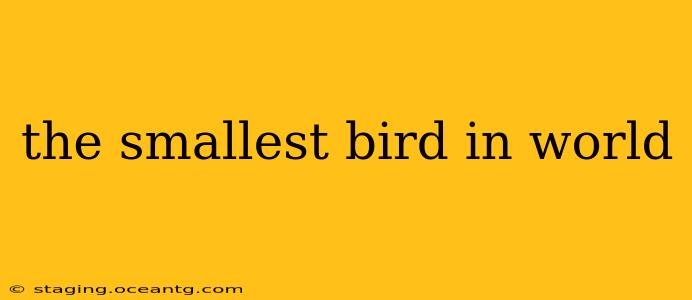The title itself hints at the answer: the bee hummingbird ( Mellisuga helenae) holds the coveted title of the world's smallest bird. This minuscule marvel of nature is so incredibly small that it's often mistaken for a large insect. But don't let its size fool you; this tiny creature boasts remarkable adaptations and a captivating life story.
How Small is the Bee Hummingbird, Exactly?
The bee hummingbird's diminutive stature is truly astonishing. Females typically measure around 5 to 6 centimeters (2 to 2.4 inches) in length, while males are slightly smaller. Their weight is equally impressive, or perhaps unimpressive depending on your perspective: they weigh a mere 1.7 grams—about the weight of a penny! To put that into perspective, some large moths are heavier than this tiny bird.
What Makes the Bee Hummingbird Unique?
Beyond its size, the bee hummingbird exhibits several unique characteristics that contribute to its survival in its challenging environment. These include:
- Rapid Metabolism: To maintain its energy levels, the bee hummingbird possesses an incredibly fast metabolism, requiring frequent feeding throughout the day.
- High Wingbeat Frequency: Its wings beat at an astounding rate of 80 beats per second, allowing for exceptional maneuverability and hovering capabilities.
- Specialized Diet: Their diet primarily consists of nectar from flowers, which provides the necessary energy to fuel their high metabolism.
- Restricted Habitat: These birds are endemic to Cuba, specifically inhabiting the eastern part of the island. Their survival is directly linked to the health of their unique ecosystem.
What Other Birds are Considered Among the Smallest?
While the bee hummingbird takes the top spot, several other contenders vie for the title of "smallest bird." These include:
- Weebill: Found in Australia and surrounding islands, the weebill is another remarkably small bird.
- Goldcrest: This tiny European bird is a close competitor to the bee hummingbird in terms of size and weight.
- Costa's Hummingbird: A North American species, slightly larger than the bee hummingbird.
What are the Threats to the Bee Hummingbird Population?
Despite their remarkable adaptations, bee hummingbirds face several threats to their survival:
- Habitat Loss: Deforestation and habitat degradation are major concerns, reducing the availability of suitable nesting sites and food sources.
- Climate Change: Shifts in climate patterns can impact the flowering times of critical nectar plants, affecting food availability.
- Predation: Although small, they are still vulnerable to predation from larger birds and other animals.
How Can We Help Protect the Bee Hummingbird?
Conserving this remarkable species requires a multifaceted approach, including:
- Habitat Protection: Preserving and restoring native forests is essential to maintaining suitable habitats for the bee hummingbird.
- Sustainable Practices: Promoting sustainable agricultural practices minimizes habitat destruction and pollution.
- Raising Awareness: Educating the public about the importance of biodiversity and the threats facing the bee hummingbird.
Frequently Asked Questions (FAQ)
What is the lifespan of a bee hummingbird?
The average lifespan of a bee hummingbird is estimated to be around 3-4 years in the wild.
Do bee hummingbirds migrate?
No, bee hummingbirds are resident birds, meaning they do not migrate. They remain within their limited habitat throughout the year.
Can I keep a bee hummingbird as a pet?
Keeping a bee hummingbird as a pet is generally discouraged. Their specialized dietary needs and delicate nature make them extremely challenging to care for in captivity. Plus, it's crucial to protect their wild populations.
Where can I see bee hummingbirds?
To observe bee hummingbirds in their natural habitat, you must travel to Cuba and focus your search on the eastern part of the island. It requires careful observation as they are very small and quick.
By understanding the unique characteristics and the challenges facing the world's smallest bird, we can contribute to its conservation and ensure the survival of this extraordinary creature for generations to come. Protecting biodiversity is crucial; let’s ensure these tiny wonders continue to grace our planet.
